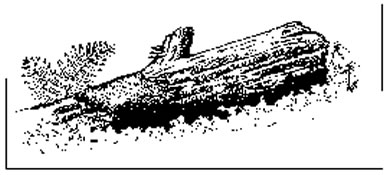Recommended Voluntary Forest Management Practices for New Hampshire
6.3 DEAD AND DOWN WOODY MATERIAL
BACKGROUND
Dead and down woody material (logs, stumps, limbs and upturned tree roots) in various stages of decay serves many critical functions.
 Dead and down woody material, often referred to as coarse wood material (CWM) or coarse woody debris, is important for nutrient retention and cycling, as nurse logs for regenerating trees and understory plants, and as wildlife habitat. Large (18+ inches) hollow or rotten logs and stumps generally have the greatest value. Softwood stands usually contain more and longer-lasting down woody material than hardwood stands. Maintaining snags and cavity trees will also serve to maintain CWM, as these trees eventually fall over.
Dead and down woody material, often referred to as coarse wood material (CWM) or coarse woody debris, is important for nutrient retention and cycling, as nurse logs for regenerating trees and understory plants, and as wildlife habitat. Large (18+ inches) hollow or rotten logs and stumps generally have the greatest value. Softwood stands usually contain more and longer-lasting down woody material than hardwood stands. Maintaining snags and cavity trees will also serve to maintain CWM, as these trees eventually fall over.
Coarse woody material is used by more than 30 percent of the region's mammals, 45 percent of the amphibians, and 50 percent of the reptiles. It's used as a feeding site by rodents, shrews, black bears, and woodpeckers and provides shelter for many small mammals. Seventeen mammal species, including black bear, otter, mink, fisher, weasels, and deer mouse either den or hunt in or under downed logs. CWM creates moist microhabitats used by amphibians. Downed logs create pools and riffles in streams that provide important fish habitat, as well as basking and nesting locations for turtles, waterfowl, mink, and otter. Several ground-nesting birds (including juncos and winter wrens) nest in upturned tree roots. Dead and down woody material provides habitat for many other organisms including insects and other invertebrates, mosses, fungi, and lichens.
OBJECTIVE
Manage for coarse woody material by retaining material that currently exists and allowing its accumulation where it is missing.
CONSIDERATIONS
- The amount of CWM is low in many forests, because of past land use. As New Hampshire forests mature, the supply of this material is naturally increasing as older trees die and fall over. However, more use of entire trees through chipping (whole-tree or biomass harvesting) or other techniques such as firewood cutting that leave less CWM in the woods may reduce the supply of this material on certain woodlots.
- Dead and down woody material is a natural component in forests. It is created in forest stands of all ages when natural disturbances such as wind and ice break tree branches or damage entire trees. Forests that aren't managed, or those managed on a rotation long enough to allow some trees to mature and naturally die often have a greater proportion of CWM material than younger stands, and are more likely to contain large diameter (18+ inches) material.
- Recruiting and retaining this material requires a conscious effort, especially when harvesting.
- CWM may have minimal economic value as biomass.
- CWM can provide a favorable microclimate for regeneration. It can protect developing tree seedlings from deer and moose browsing when the trees are young and vulnerable to browsing damage.
RECOMMENDED PRACTICES
- Avoid damaging existing CWM, especially large (18+ inches), hollow or rotten logs and rotten stumps.
- Leave cull material from harvested trees, especially sound, hollow logs, in the woods. Leave some cull material in the woods during whole-tree or biomass harvests. Return large pieces of cull material bucked-out on the landing to the woods.
- Avoid disrupting downed logs in and adjacent to streams, ponds and wetlands.
- Avoid disrupting upturned tree roots from May through July to protect nesting birds.
- Maintain or create softwood inclusions in hardwood stands to provide a supply of longer-lasting down woody material.
- Collect information about the type and abundance of CWM as part of a forest inventory.
CROSS REFERENCES
2.2 Forest Structure; 3.1 Timber Harvesting Systems; 3.2 Logging Aesthetics; 4.2 Wetlands; 4.3 Forest Management in Riparian Areas; 4.4 Stream Crossings and Habitat; 5.3 Ice and Wind Damage; 6.2 Cavity Trees, Dens and Snags; 6.4 Overstory Inclusions.
ADDITIONAL INFORMATION
DeGraaf, R., M. Yamasaki, W. B. Leak, and A. M. Lester. 2006. Technical Guide to Forest Wildlife Habitat Management in New England. University of Vermont Press and University Press of New England, Burlington, Vt. 305 p.